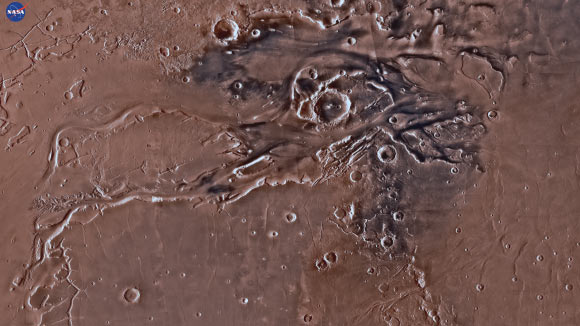Catastrophic floods generated 3.2 billion years ago by rapid groundwater outbursts scoured the Solar System’s largest flood channels on Mars. Based on NASA’s Viking Orbiter data analysis, it was hypothesized that this was caused by the release of water from a global aquifer. But a new study, led by Dr Alexis Rodriguez of the Planetary Science Institute, reveals regional deposits of sediment and ice emplaced 450 million years earlier to be the source.
“The flooding is due to regional processes, not global processes,” Dr Rodriguez said.
“Deposition of sediment from rivers and glacial melt filled giant canyons beneath a primordial ocean contained within the planet’s northern lowlands,” he explained.
“It was the water preserved in these canyon sediments that was later released as great floods, the effects of which can be seen today.”
The canyons filled, the Martian ocean disappeared, and the surface froze for 450 million years.
Then, about 3.2 billion years ago, lava beneath the canyons heated the soil, melted the icy materials, and produced vast systems of subterranean rivers extending hundreds of miles. This water erupted onto the now-dry surface in giant floods.
“Our investigation suggests that early Mars sedimentation could have buried and trapped enormous volumes of surface water, perhaps triggering the transition into the frozen world that Mars has been during most of its history,” Dr Rodriguez said.
“Evidence for ancient environments capable of sustaining Earth-like life forms could be present in subsurface materials that are now exposed.”
He added: “because the process of deposition, freezing, heating and eruption were regional, there may be vast reservoirs of water ice that are still trapped beneath the Martian surface along the boundaries of its ancient northern ocean as well as within the subsurface of other regions of the planet where contemporaneous seas and lakes formed.”
“This could be critical to the future of human activity on Mars,” Dr Rodriguez concluded.
The results were published online September 8 in the journal Scientific Reports.
_____
J. Alexis P. Rodriguez et al. 2015. Martian outflow channels: How did their source aquifers form, and why did they drain so rapidly? Scientific Reports 5, article number: 13404; doi: 10.1038/srep13404








